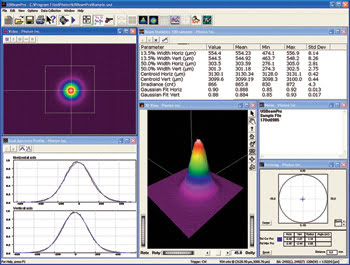USB-enabled beam profiling systems offer advantages in field service and flexible manufacturing situations.
Derrick Peterman, Photon Inc.
In consumer products, the universal serial bus (USB) increases convenience and improves function, and it has enabled the widespread adoption of new technologies. For example, USB connectivity in digital cameras has helped to transform the PC into a home photo development laboratory, rendering the cameras superior to their analog film counterparts for most consumer uses.
The benefits made possible with USB have filtered into nonconsumer markets as well, and the standard is increasingly present in test equipment. USB is available in the beam profiling equipment used to characterize lasers and optics. These beam profilers are based on a silicon CMOS array sensor and provide two-dimensional measurements over a 350- to 1100-nm wavelength range. Users have been able to exploit the increased portability provided by USB, reducing their cost, increasing production throughput and providing better service to customers.

The beam profile displayed here was collected using a USB-enabled profiler.
Beam profiling equipment that does not use USB typically involves a PC-based software interface to display and record data and to control the instrument. This requires a peripheral component interconnect (PCI) card installed inside the computer. To move the beam profiler between PCs, therefore, one must physically open the computer and transfer the PCI card to the other station.
A hardware trend further complicates portability. PCI card slots normally are found in desktop and large industrial computers, and are not usually in compact laptop computers. Operating PCI-based equipment with laptop computers thus requires additional hardware and software, which makes them much less portable.
USB connectivity eliminates this problem. A beam profiler with USB does not require additional electronic cards; it simply plugs into the USB port. And because there is no need for additional hardware, a laptop computer remains highly portable when used with these beam profilers.
Benefits in photonics
This portability is a distinct advantage in field service applications. A field service engineer often carries many diagnostic tools to troubleshoot and calibrate equipment in the field. Ideally, all the software needed to operate these tools and to store the data can be installed onto a portable computer’s hard drive, and each tool can be plugged into the USB port. A beam profiler with USB connectivity can be easily introduced into the engineer’s tool kit.
Flexible manufacturing is another application in which USB-enabled instrumentation is ideal. Many firms in the photonics industry serve niche markets, which typically have limited production runs, often at sporadic intervals. In these situations, production equipment dedicated to a single product is difficult to justify. Test equipment with USB facilitates the arrangement and configuration of production setups for different products. A single computer can be used to operate a test station that is installed with the software required to run all the test equipment. Whatever equipment is required to perform the tests prior to shipment can be installed in a plug-and-play fashion.
Another example in the photonics industry where beam profiling equipment with USB has a distinct advantage is research and development laboratories. Equipment with USB is more easily shared and more readily available, allowing the labs to share costs.
Data rates
Still, USB is inadequate for certain beam profiling applications. Highly precise measurements of beam size and position require high-resolution scans with high data counts. For the real-time measurement of beam profiles and of the beam parameters needed for laser diagnostics and active optical alignment, the data rates available with USB 2.0 are inadequate. Thus, USB is not particularly suited to high-precision beam profiling.
It also often is not a suitable interface for the measurement of multiple beam profiles at several locations using a single computer. Although it is certainly possible to operate several beam profilers with the same computer via USB, the data rates result in slow image capture. Because such work generally requires real-time data, USB usually is not a viable choice.
For these applications, a PCI-based beam profiling system is required because it supports the necessary data rates.
Meet the author
Derrick Peterman is a sales engineer at Photon Inc. in San Jose, Calif.; e-mail: [email protected].